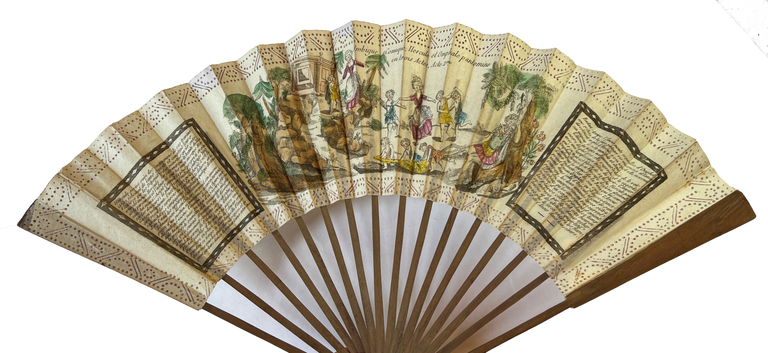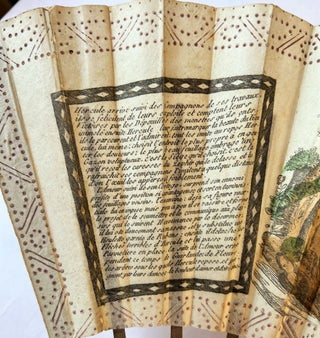Printed fan for the Ambigu Comique theater, with caption “Ambigu Comique; Hercule et Omphale pantomime en trois Actes, Acte 2eme.” [Paris, ca. 1790-91].
Hand-colored etched and engraved folding paper fan, printed on recto of a single sheet, backed in plain paper, mounted on original plain wooden sticks, the open leaf measuring approx. 130 x 400 mm., total fan height (including mount) 280 mm. The engraving shows a scene from the pantomime Hercule et Omphale, hand-colored in watercolor, flanked by compartments containing engraved text, within a stencil-printed pink decorative border. In fine condition. ***
A rare and beautifully preserved printed fan showing scenes from a popular pantomime, performed by teenagers and children.
The first “theater” of the actor, playwright and impresario Nicolas-Ménard Audinot (1732-1801) was a marionette theater at the annual Saint Germain fair; each of his wooden marionettes represented an actor from the Comédie Italienne. His success led him to open a real theater, called the “Ambigu Comique,” in 1769. Soon after opening, the players were changed from puppets to real children. In spite of restrictions posed on his theater by Audinot’s competitors, the more “serious” Opéra, Comédie Française and Comédie des Italiennes, his popular theater on the boulevard du Temple attracted the largest crowds of all.
By the time of the Revolution, the gimmick of child-actors had grown stale, and Audinot replaced the smallest childen with teenagers. This period saw the vogue for heroic and historical “pantomimes,” musical performances with dance. According to Soleinne, Audinot’s Hercule et Omphale was first performed in 1790. The BnF has a manuscript score for the piece, containing the music by Jean-Baptiste Rochefort, with the date 1787 (possibly the date of composition).
In this fan, the engraved text on either side of the image reproduces the first part of the description of Act 2 from the libretto of which a printed edition (Paris: Potier de Lille, [ca. 1790-1794]), is held by the BnF and reproduced on Gallica The plot of the pantomime-ballet simplifies the story of Omphal (Queen of Lydia) and Hercules. The scene shown on the fan, set in a lovely spot near the sea, next to a mountain “bristling with rocks and bushes,” is the happiest part of an otherwise violent and finally poignant ballet. Hercules, having killed the lion that threatened Omphal and her court, takes a rest under a tree. Love arrives during his nap, and her assistants disarm him, replacing his club with a beribboned staff. They dance and sing. Meanwhile Love has found Omphal in her pavilion on the mountaintop, and guides her down to Hercules. The fan shows the events occurring simultaneously. Love’s helpers are children.
Fans like this one were probably sold as souvenirs at the theater. The style and coloring of this engraved fan resemble that of another keepsake from the Ambigu Comique, a rare harlequinade recently sold by us (see our catalogue 18). Perhaps the theater employed one or two regular imagiers for its “merchandise,” but this is speculation, given the paucity of archival documentation of this sector of the popular print trade.
Soleinne, Bibliothèque dramatique III: 225; cf. E. Deligny, Histoire de l'Ambigu-comique depuis sa création jusqu'à ce jour (Paris 1841), p. 38; Enciclopedia dello spettacolo (1954), I: 1122. Item #4243
Price: $3,250.00


